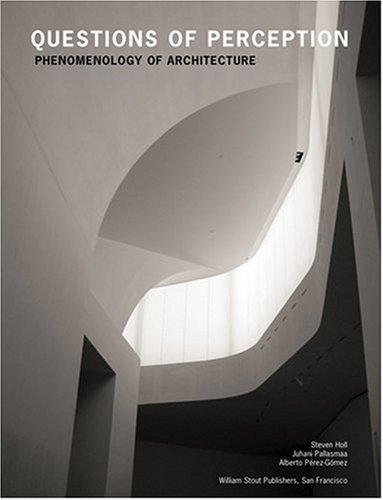Questions of Perception: Phenomenology of Architecture download
Par blanchard ann le samedi, juin 10 2017, 00:31 - Lien permanent
Questions of Perception: Phenomenology of Architecture by Steven Holl, Juhani Pallasmaa, Alberto Perez-Gomez


Download eBook
Questions of Perception: Phenomenology of Architecture Steven Holl, Juhani Pallasmaa, Alberto Perez-Gomez ebook
Format: pdf
Page: 155
ISBN: 0974621471, 9780974621470
Publisher: William Stout
The redesign of the building, in the heart of Rome, was based on the winning proposal submitted for the competition which was held in 1995, but has only now been completed as an architectural space and as a working library. In examining the two architects side-by-side, Morris places them in conversation with one another, implicitly underlining their similarities as well as their essential differences. Steven Holl, Juhani Pallasmaa, and Alberto Perez-Gomez, Questions of Perception: Phenomenology of Architecture, 2nd ed (San Francisco: William Stout Publishers, 2006), p.29. Questions of Perception : Phenomenology of Architecture. In relation, phenomenology of architecture is looking at architecture from within the consciousness experiencing it, through architectural feelings and emotions. A unique meaning and intensity can evolve to hold these together and work within the system. Architecture from the Inside Out: From the Body, the Senses, the Site and the Community. Her filmic choices also reveal an ongoing These works use deceptively simple means to transform and complicate the spaces they occupy, throwing into relief the interrelated questions of perception and phenomenology that have occupied the artist for over four decades. In order to stop the alienation of architecture, we must strive towards a higher awareness of multi-sensory perception in contemporary architecture. ' - Questions of Perception- Phenomenology of Architecture by Steven Holl p112. It is design-space that temporally re-calibrates its relationship with the outside world, repeatedly and through time, either by actively transforming its physical and conceptual boundaries, or through translating its phenomenological perception by the user. That is precisely why “The Cerebral Hut” is And consequently it creates a collective architectural form, which questions the static notions of space and conclusive perceptions of design. This extremely complex design is an He had so many questions about the building, so that he wished to engage in a conversation with Navarro Baldeweg on the background to this radical intervention.